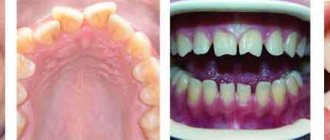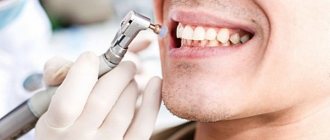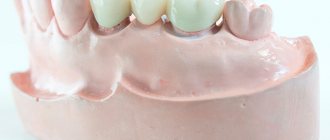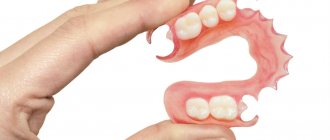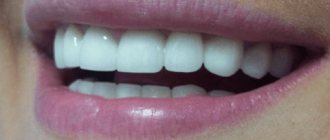Crowns are non-removable orthopedic structures for restoring the upper (coronal) part of damaged teeth. Artificial crowns, made from modern materials, completely replicate the shape and color, and do not differ in appearance from natural teeth . Retains its original appearance throughout its entire service life and is resistant to chewing loads. Service life and cost depend on the technology and material of manufacture. Metal-free structures installed in our Center are provided with a 25-year warranty, unique for Russia .
Indications for installation
The purpose of an orthopedic crown is to restore the chewing function of the tooth and protect the roots from further destruction. The main condition is that the tooth root must be healthy, without inflammatory processes.
In what cases are crowns installed?
- Destruction of the crown part of the tooth by more than 50%, when it is impossible to restore it with filling material.
- Abrasion of teeth. Develops due to incorrect functioning of the lower jaw joint and malocclusion.
- Teeth straightening. As an alternative to orthodontic treatment.
- Unsatisfactory aesthetics. Chips, cracks, discoloration of tooth enamel.
Crowns are durable and retain their shape and color for a long time, unlike therapeutic restorations.
Metal-ceramic dental bridge
A metal-ceramic bridge combines the advantages of solid and ceramic prostheses. This type of prosthetics is characterized by high strength, aesthetics and biocompatibility with oral tissues.
Indications:
- absence of 2-4 adjacent teeth in the anterior zone;
- absence of 1 tooth in the chewing area;
- the presence of healthy supporting teeth that can withstand the chewing load.
Despite the advantages of installation, there are many contraindications.
When should a metal-ceramic prosthesis not be inserted?
Contraindications:
- absence of more than 4 incisors in a row;
- bruxism;
- bite pathology;
- gum disease;
- pathological abrasion of incisors;
- inflammatory processes in the mouth;
- poor hygiene (developing infection).
Types of crowns
Zirconium dioxide
Manufactured from a single block of zirconium dioxide automatically on computer-controlled machines.
Indistinguishable from living teeth, ideal for front teeth. 100% biocompatible, non-allergenic, incredibly durable and does not require extensive grinding of the enamel. Ceramic E-max
Made from glass ceramics based on lithium disilicate.
Can be used in any part of the jaw. Inferior in strength to zirconium crowns. Preparation is minimal. Externally identical to natural teeth, translucent, like real teeth.
Content
- Is it possible to put a bridge on implants?
- Is it possible to install a bridge on an implant and your own tooth?
- Advantages of dental bridges on implants
- Implant-supported bridge
- How long does it take to get used to dental bridges?
- There is no need to depulp adjacent teeth
- What does a dental bridge look like?
- How long does a dental bridge last?
- How much does it cost to install a dental bridge?
- Full jaw dental bridge
- Cost of a metal-ceramic dental bridge
- Dental bridge materials
- Metal-ceramic dental bridge
- Plastic dental bridge
- Zirconium dioxide dental bridge
- Ceramic dental bridge
The guarantee on crowns in our Center is 25 years
Our Center provides a unique guarantee for metal-free crowns milled in our own digital dental laboratory. The warranty is valid for 25 years and covers structural integrity and color stability. With proper use and compliance with all recommendations of the treating physician, crowns will last a lifetime .
We place crowns - once and for all !
We have structured the work of the orthopedic department in such a way as to ensure uncompromising quality of prosthetics. The transition to digital technologies ensured clear interaction between the orthopedist and the dental technician, the elimination of errors, and the jeweler-like precision of the manufacture of each crown. This allows us to give a guarantee exclusive to Moscow - 25 years.
Levin Dmitry Valerievich Chief physician and founder of the Doctor Levin center
The extended warranty is based on 5 components:
Orthopedist
The role of an orthopedic dentist is difficult to underestimate. The specialist is responsible for the final result of treatment - teeth that should last the patient a lifetime. The doctor plans treatment at the intersection of design and ideal function of future teeth. Not only the patient’s wishes regarding the color and shape of future teeth should be taken into account, but also the patient’s age, shape and complexion, characteristics of the bite and function of the temporomandibular joint, the condition of living teeth and gums, the structure and quality of bone tissue and much more, even assessment of the functioning of the cardiovascular system.
The requirements for the Center's doctors are extremely serious. We do not hire doctors “off the street” or by advertisement. By recommendation only. Experience - 10 years or more with proven practical and manual skills. We hire only excellent students with honors, clear clinical thinking and deep theoretical knowledge, including interdisciplinary knowledge. The salaries of the Center’s doctors are 30% higher than the average in Moscow, we work with the best of the best .
Diagnostics
When faced with the task of installing crowns for life, it is critically important to assess all hidden threats to new teeth, to anticipate and eliminate any risks. The condition of all dental roots, canals, maxillary sinuses, bone tissue, jaw joints, the trajectory and position of the lower jaw, bite, jaw relationship and much more are examined.
For diagnostic and planning purposes, Seiler dental microscopes, a high-precision 3D tomograph Siemens Sirona Orthophos SL 3D with an ENT function, diagnostic complexes SAM3, Protar or Amann Girrbach, a neuromuscular stimulator MIST TENS, a digital scanner 3shape Trios 3 are used.
Control
The chief physician approves each stage of the treatment plan, the order of stages, and adjusts priorities and the basic treatment plan if necessary. The quality control system at the Center is organized in such a way as to eliminate or minimize errors and complications during the treatment process. Each patient is assigned a person in charge, for example, a Leading Orthopedic Dentist or a Chief Physician. In accordance with the Unified Standards of the Center, photo and x-ray recordings are carried out before and after each manipulation. Those in charge daily monitor the process and results of the treatment, starting with the quality of comprehensive oral hygiene before surgery, ending with the dynamics of changes in the position of the teeth during orthodontic treatment.
Installation
Teeth preparation is a responsible process, 100% dependent on the manual skills and practical experience of the orthopedic dentist, the equipment of the office and the doctor’s working conditions as a whole. For example, in accordance with the Unified Quality Standards, in order to avoid the slightest risk of committing a medical error, clinic employees are not recommended to speak loudly during working hours and are prohibited from opening the door to the office during surgery. Orthopedic preparation of teeth for the installation of dentures is carried out with optical magnification using dental microscopes, which are equipped in each office. Magnification allows maximum preservation of healthy tissues and avoids damage to the dental pulp and soft tissues. Orthopedic assistants are specialized medical personnel with proven continuous practice of working with an orthopedist “in 4 hands”, on a dental microscope and with letters of recommendation from previous places of work.
Precision Manufacturing
The service life of a crown depends 40% on the quality of workmanship. The classic process involves the participation of a dental technician and manual modifications that do not always fully correspond to the ideal result. The production process in the dental laboratory of the Center is fully automated - a computer model of the future crown is transferred to the ZirkonZahn milling machine electronically and is machined from the workpiece without human intervention. The technology allows us to produce crowns with pinpoint accuracy down to 1 micron .
Metal-ceramic crowns are not manufactured in the dental laboratory of the Center; they are ordered from a third party. The extended warranty is provided only for metal-free zirconium and ceramic crowns manufactured by the Center’s dental laboratory.
Chashchin Kirill Valerievich
Orthopedic dentist, 14 years of experience
Digital prosthetics. Aesthetic restorations with veneers with a lifetime guarantee. Total orthopedic rehabilitation in one day
More about the doctor
What measures need to be taken?
If the crown becomes loose, you should consult a doctor as soon as possible. You should not remove the microprosthesis yourself, as infection may enter the tissue. A doctor must remove the orthopedic structure. After removing the crown, the dentist:
- removes soft tissue
- carries out antiseptic treatment,
- restores the deformed base,
- installs an old crown or makes a new one.
The treatment regimen depends on the clinical picture. It is not always possible to save the crown.
Own digital dental laboratory
The presence of a digital laboratory in the clinic improves the interaction between the orthopedist and the dental technician and reduces production time
- Digitalization of the production process reduces errors to a few microns
- Possibility to make a prototype and try on a crown on the day of modeling
- Accelerated production times - from 3 days
Digital protocol - for maximum accuracy
A digital impression, a 3D image of the jaw, and a computer model of the future smile are digitally transferred to the laboratory. Manufacturing accuracy up to 1 micron.
- Obtaining optical impressions using a 3D scanner
- Virtual modeling of WaxUp crowns and MockUp fitting
- Automated production on a ZirkonZahn milling machine
Installation steps
Design approval
When restoring anterior teeth (when it is important to achieve maximum aesthetics) or a group of chewing teeth (when it is important to restore the correct closure of the jaws), preliminary modeling of future crowns is performed even before work begins. Digital prototyping reduces time and number of visits, improves mutual understanding between doctor and patient.
- Wax-up - you can look, but you cannot try on Using an intraoral scanner, digital impressions are taken and transferred to a computer. A special Exocad program creates a three-dimensional 3D model of teeth, on which the orthopedist carries out modeling - increasing the missing volume digitally. The result can be combined with a photograph of a person, so the patient, looking at a computer monitor, can evaluate the future result - how much the shape of the teeth will be changed.
- Mock-up - you can try on and evaluate future teeth. After agreeing on the virtual shape of the teeth, the three-dimensional model is transferred to an optical printer, which prints a prototype of future crowns. You can try them on, evaluate how it will look in your mouth, and feel when you close your teeth. Even before the start of treatment, without preparing the enamel, you can evaluate the comfort and aesthetics of future structures. If something is not satisfactory, adjustments are made directly to the Mock-up, which are taken into account in the manufacture of permanent structures.
In case of total work or malocclusion, it is necessary to study the closure of the jaws at the diagnostic stage - the parameters are necessary to create ideal crowns that will not disturb the position of the temporomandibular joint.
Preparing the teeth
When the design has been agreed upon, the teeth are prepared - it is necessary to remove the volume of enamel to the thickness of the future structures. It is performed under a microscope - optical magnification helps to carry out the work carefully and as carefully as possible in relation to your own tissues, preserving them to the maximum.
Tooth preparation is a process that requires precision. It takes at least 20 minutes to grind one tooth; for large-scale work it takes several hours. It requires patience and perseverance not only from the doctor, but also from the patient. Moreover, it is performed under anesthesia. For those who want to spend this time in comfort, our Center provides sedation - immersion in controlled drug sleep. The process will take place without pain and nervous overload. Awakening is easy, in a clear consciousness - this is not general anesthesia.
Digital impressions are again taken of the ground teeth and, together with photometric data and readings recorded using the articulator, are transferred to an optical milling machine for the production of crowns. Production takes from 3 to 10 days.
During this time, the teeth are covered with temporary structures - they are made immediately on the day of preparation.
They provide protection from the negative effects of external factors, aesthetics and functionality during the production of permanent crowns. Installation of crowns
The manufactured structures are first fixed with temporary cement, the patient evaluates the shape, color, and comfort of closure. During total work, the closure of the jaws on the articulator is again assessed. If corrections are necessary, adjustments are made in the laboratory taking into account the patient's wishes.
After modifications, permanent installation is carried out - the crowns are fixed to a permanent dental compound under the control of a dental microscope.
Treatment of wisdom teeth at home
Full treatment of wisdom teeth takes place only in the dentist’s office, and this applies to all the diseases described above. Under no circumstances should you expect pain and inflammation to go away on their own, or take various medications without the knowledge of your doctor. Negligence can lead to the most unpleasant consequences and even death. If pericoronitis is detected in the initial stage, the doctor may suggest a conservative rehabilitation method (which happens extremely rarely), but even in this case, treatment of inflammation of the wisdom tooth at home should be carried out under the supervision of a specialist.

